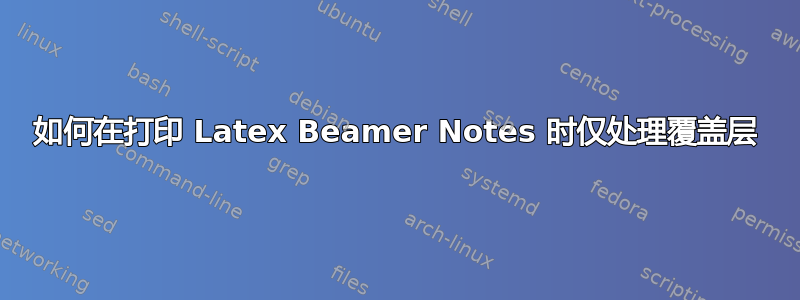
使用叠加层并在同一张幻灯片中显示多个图形甚至文本确实很棒,但我真的很想知道如何在打印幻灯片或笔记时显示每个叠加层?似乎有些幻灯片可以有多页才能准确显示所有图形和文本,尤其是当我们使用诸如\only<1-3和之类的叠加层时\only<4-5>。如果它只是普通文本并且只填充一页,那么应该没问题。但很多时候情况比这更复杂。有人能澄清一下我们在这种情况下能做什么吗?
编辑:添加了最少的示例
我的意思是,在第二张幻灯片上,我有三张不同的 tikz 图片。这里我没有包含节点 (0,0) 上的图片。在我的幻灯片中,我使用了图片。那么,我怎样才能在同一页上打印这三张图片?在其他情况下,一些文本也不适合幻灯片。我希望现在更容易理解了。
一个最小的工作示例
%\documentclass[mathserif]{beamer}
\documentclass[arial,handout]{beamer}
\usepackage{pgf,pgfpages}
\usepackage{graphicx}
%\usepackage{units}
%\usepackage[utf8]{inputenc}
\usepackage{mathtools}
%\usepackage{amsmath}
\usepackage{animate}
\usepackage{booktabs}
\usepackage{tikz}
\usetikzlibrary{arrows,shapes}
\tikzset{
invisible/.style={opacity=0},
visible on/.style={alt=#1{}{invisible}},
alt/.code args={<#1>#2#3}{%
\alt<#1>{\pgfkeysalso{#2}}{\pgfkeysalso{#3}} % \pgfkeysalso doesn't change the path
},
}
\mode<presentation>
{
\usetheme{ift}
\setbeamertemplate{items}[square]
}
\usefonttheme[onlymath]{serif}
\setbeamerfont{frametitle}{size=\LARGE,series=\bfseries}
\definecolor{uibred}{RGB}{170, 0, 0}
\definecolor{uibblue}{RGB}{0, 84, 115}
\definecolor{uibgreen}{RGB}{119, 175, 0}
%\definecolor{uibgreen}{RGB}{50, 105, 0}
\definecolor{uiborange}{RGB}{217, 89, 0}
%% Create a new command called redub for underbraces
\newcommand\redub[2]{%
\colorlet{currentcolor}{.}%
\color{red}%
\underbrace{\color{currentcolor}#1}_{\color{red}#2}%
\color{currentcolor}%
}
%Beamer block template
\setbeamertemplate{blocks}[rounded][shadow=true]
\setbeamercolor{block title}{bg=uibblue,fg=white}
\setbeamercolor{item projected}{fg=white,bg=green}
\beamertemplatenavigationsymbolsempty
%\include{macros}
%\includeonlyframes{current}
\defbeamertemplate{enumerate item}{mycircle}
{
%\usebeamerfont*{item projected}%
%\usebeamercolor[bg]{item projected}%
\begin{pgfpicture}{0ex}{0ex}{1.5ex}{0ex}
%\pgfcircle[fill]{\pgfpoint{0pt}{.75ex}}{1.25ex}
\pgfbox[center,base]{\color{uibblue}\insertenumlabel.}
\end{pgfpicture}%
}
[action]
{\setbeamerfont{item projected}{size=\scriptsize}}
\setbeamertemplate{enumerate item}[mycircle]
\begin{document}
%\setbeamertemplate{background}
% {\includegraphics[width=\paperwidth,height=\paperheight]{slide_bg1}}
%\setbeamertemplate{footline}[ifttheme]
\mode<presentation>
\begin{frame}
\frametitle{Eulerian Salt Flux Decomposition}
\only<1-2>{\begin{itemize}
\item Subtidal Volume discharge rate $Q_f$: through a cross=section A \\
$Q_f = \langle\int u.dA \rangle$
\item Salt transport rate $F_s$ through a cross-section A \\
$F_s = \langle \int uS.dA \rangle$
\end{itemize}}
\onslide<2->Sub-tidal salt flux decomposed into three parts
\onslide<2->\begin{align*}
F & = \langle \int(u_0+u_E+U_T)(s_0+s_E+s_T)dA \rangle \\
& \approx \langle \int(u_0s_0+u_Es_E+u_Ts_T)dA \rangle \\
& = \redub{Q_fs_0}{\mathclap{\text{ River flow }}} +
\redub{F_E}{\substack{\text{Exchange}\\\text{shear dispersion}}} +
\redub{F_T}{\substack{\text{tidal osciallatory}\\\text{salt transport}}}
\end{align*}
\onslide<3->\begin{itemize}
\item $u_0$ and $s_0$ tidally and cross-sectionally averaged
\item $u_E$ and $s_E$ tidally averaged and cross-sectionally varying
\item $u_T$ and $s_T$ tidally and cross-sectionally varying
\end{itemize}
\end{frame}
\begin{frame}
\frametitle{Age of Water under dye from all Rivers}
\only<1-3>{\begin{tikzpicture}
\centering
\node [](0,0)(start){ hello2};
% \draw [step=0.5cm,thin,dotted] (-5,-4) grid(5,4);
% \node [circle]at (-4.5,0){0};
% \node [circle,radius=0.9cm,fill=red!30,] at (-4.5,0)(a){};
\draw [red,fill=red!30](-4.3,-0.2)circle(0.1cm);
\draw [red,fill=red!30](-3.3,0)circle(0.1cm);
\draw [red,fill=red!30](-2.5,-0.7)circle(0.1cm);
\draw [red,fill=red!30](-4.,-0.8)circle(0.1cm);
\draw [red,fill=red!30](-4.,-1.2)circle(0.1cm);
\draw [red,fill=red!30](4.3,1.6)circle(0.1cm);
\draw [red,fill=red!30](3.3,2.7)circle(0.1cm);
\draw [red,fill=red!30](1.6,3.5)circle(0.1cm);
\draw [red,fill=red!30](1.3,3.5)circle(0.1cm);
\node [rectangle,text width=4cm,red] at (5.5,3) (return) {$Q_2 = 169 A^{0.616}$ \linebreak Mason et. al. 1998};
\node [rectangle,text width=4cm,red,visible on =<2->] at (5,0) (return) {Smaller near the source \linebreak Increases away from the source};
\draw [red,visible on =<3->](-3.3,-1.5) circle(0.7cm);%wolf bay small age
\end{tikzpicture}}
\only<4-5>{\begin{tikzpicture}
\node [](0,0)(start){hello1};
% \draw [step=0.5,dotted](-5,-4) grid (5,4);
\node [rectangle,text width=4cm,red] at (5,0) (return) {Scale different from \linebreak 2 year inflows};
\node [rectangle, text width =4cm, red,visible on =<5->] at (5,-2) {Maximum age of 120 days};
\draw [red] (1.5,-1) ellipse(1cm and 0.6cm);
\node [rectangle, text width=4cm, red] at (5,3) {Minimum 7 day flow over 10 yr. interval};
\end{tikzpicture}}
%
\only<6-7>{\begin{tikzpicture}
\node [](0,0)(start){hello};
\node [rectangle, text width=4cm, red, visible on =<7->] at (5,3) {Mean inflows over 10 yr. interval};
\end{tikzpicture}}
\end{frame}
\end{document}
答案1
将我的上述评论转化为答案:
在指定叠加选项时,您可以添加选项handout:<number>。例如,\only<1-3| handout:1>{content-1}将打印content-1出现在第 1 至第 3 帧中的作为讲义第一页的内容;\only<4-5| handout:2>{content-2}将打印content-2出现在第 4 和第 5 帧中的作为讲义第二页的内容;并将\only<6-| handout:0>{content-3}指示 beamer 不要打印出现在第 6 帧及以后的内容。请注意,和content-3之间需要一个空格。|handout
若要不在讲义中显示某个项目/图形,只需设置handout:0。


